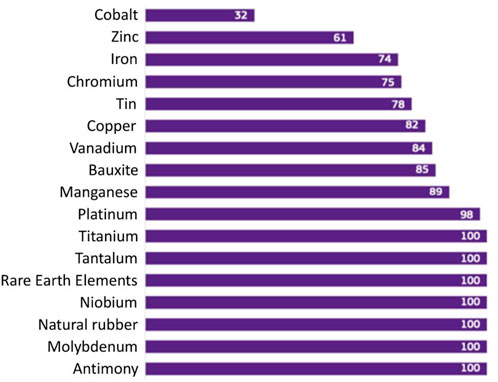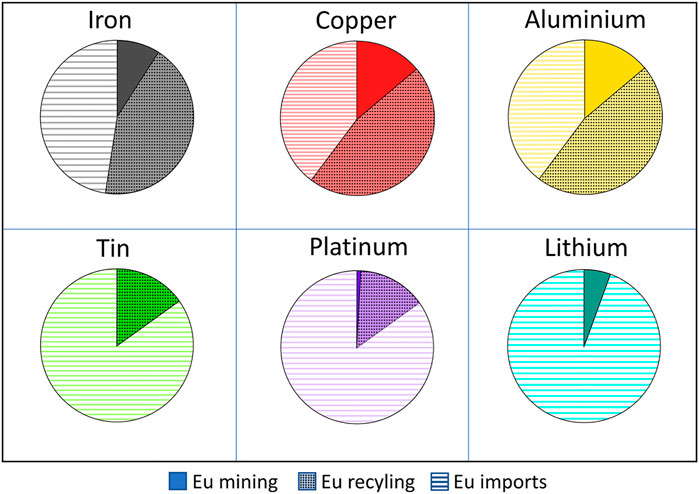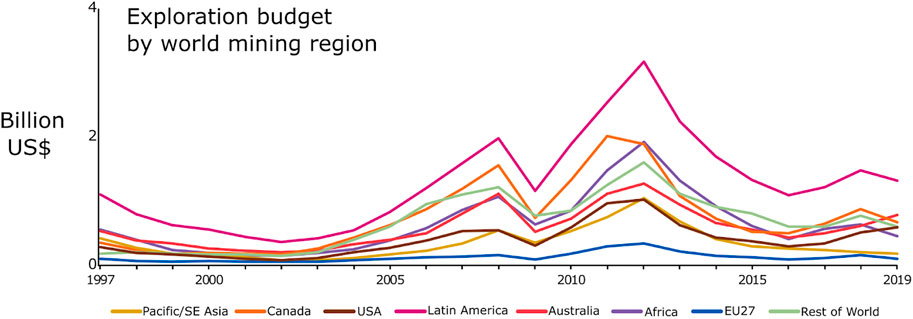- 1Natural Resources & Sustainable Development, Department of Earth Sciences, Uppsala University, Uppsala, Sweden
- 2ISTerre, Université Grenoble Alpes, Grenoble, France
Europe’s almost total dependence on foreign suppliers of metals impacts negatively on the continent’s balance of trade, opens the region to potentially damaging supply problems, allows foreign actors to place political demands on European leaders and economies, and has a considerable negative environmental impact in many parts of the world. Europe has sound economic reasons, and a moral responsibility, to promote more mining in the many parts of the continent where it can be conducted in a responsible and sustainable manner.
Each European consumes between 17 and 25 tonnes of metals and mineral products per year (United Nations, 2019), but European production covers only a small fraction of domestic demand and the region relies almost totally on foreign sources (Figure 1). The war in Ukraine and sanctions against Russia have brought to the fore the issue of supply security and Europe’s alarmingly limited raw materials resilience. The problem is compounded by a looming surge in global demand for most mineral products, as global population increases, as lesser-developed countries progress economically, as new technologies increase the demand for an expanding list of industrial metals, and as the infrastructure for the energy transition is constructed (Dessart and Bontoux, 2017; Schüler et al., 2017; Vidal-Legaz et al., 2018; Nkulu et al., 2018; COM/2020/474, 2020; Hund et al., 2020; European Commission, 2020a; European Commission, 2020b; Jowitt et al., 2020; Sovacool et al., 2020). For example, conversion of the UK’s fleet of over 30 million cars and trucks to battery-electric vehicles, will consume over 200,000 tonnes of cobalt, over 260,000 tonnes of lithium carbonate, over 7,000 tonnes neodymium and a phenomenal 2.3 million tonnes of copper. This amounts to twice the current annual world production of cobalt, an entire year’s world production of neodymium and three quarters of global production of lithium (Herrington 2021). Recycling, often cited as the solution, will provide a portion of the shortfall, but current stocks of used materials cannot supplant the need for primary production, at least for the next few decades (Vidal et al., 2013; Arndt et al., 2017; Figure 2).

FIGURE 1. EU import reliance for selected raw materials – metals and natural rubber (Vidal-Legaz et al., 2018). There is no domestic production of titanium, tantalum, REE, niobium, natural rubber, molybdenum and antimony in the EU, and for almost all the other materials, the EU only has a minor production and relies mainly on imports.

FIGURE 2. EU-28 source of selected metals from EU mining, EU recycling and EU imports of ores and intermediate products (rough estimation of metal content in total volumes, estimation for 2014). Modified after Schüler et al. (2017).
Fuelled by the COVID-19 pandemic, resource nationalism has taken hold all over the world. “National sovereignty” has become a subject of vigorous debate as governments recognise the need to avoid dangerous dependence on foreign suppliers for its high-tech industries. The debate has centred on pharmaceuticals and manufacturing and the supply of raw materials has received very little attention in the public domain.
On 8 March, President Putin signed an order to prohibit the export of a series of products and raw materials. Although raw metal exports are not yet included, import restrictions imposed by European and other governments, and post-pandemic transport problems have led to dramatic increases of global metal prices. Currently Russia produces almost half of the world’s palladium, a metal used for pollution control devices on motor vehicles and in the aerospace industry, and supplies Europe with 80% of its nickel and a large fraction of its copper, aluminium, platinum, titanium and vanadium (cf. Schüler et al., 2017; Ragonnaud and Szczepanski, 2022). While the EU’s dependence on Russian oil and gas is far more critical, disruption of supplies of these metals, or an increase in their prices caused by global shortages, would have a significant negative impact on European industry and on the global economy. These events might be expected to lead to greater production of metals within Europe, but going on past history, and events in the past year, this is by no means assured.
In Europe, many proven and potential ore deposits are not being exploited (COM/2020/474, 2020; Dessart and Bontoux, 2017; Vidal-Legaz et al., 2018; European Commission, 2020a; European Commission, 2020b). Although many older mines have had substantial environmental impact, modern operations like Boliden’s Aitik or LKAB’s Kiruna mine in northern Sweden demonstrate that mining can be conducted profitably and responsibly in Europe while respecting the stringent social and environmental standards imposed by the Swedish government (Sweden’s Ministry of Enterprise, Energy and Communications, 2013). Yet in the past year, many European governments have taken measures to oppose rather than promote mining. For example, major protests led Scandivanadium to walk away from a major Swedish vanadium project, the Serbian government has cancelled permits awarded to the Rio Tinto company to develop a major lithium deposit, and ongoing public opposition at Mina do Barroso in Portugal threatens to derail one of the most promising lithium mining operations in Europe. The consequence is that metals that are essential for European industries must be imported, often from far flung places, adding transport costs and carbon miles, as well as jeopardising secure supply of these metals.
Government agencies, both national and European, have long been aware of the problem. In 1989 the newly formed European Economic Community (EEC) launched a major initiative aimed at securing a supply of raw materials for European industry, partly by facilitating domestic production. This was followed, in 2008 and 2020, by two other initiatives with similar objectives. In parallel, numerous national and European research programs and professional associations have been established—PROMINE, ERAMIN 1 and 2, the European Raw Materials Alliance (ERMA), Minerals4EU, successive EC Framework programs, and several programs in Horizon 2020.
These initiatives and research programs have fostered some excellent research that has improved our knowledge of the complete raw materials supply chain, but they appear to have had little impact on European raw materials resilience. For example, the EC Raw Materials Scoreboard (European Commission, Directorate-General for Internal Market, Industry, Entrepreneurship and SMEs, 2021) shows that the level of mineral exploration in Europe has remained roughly constant through the past two decades. The overall level of expenditure has remained extremely low, persistently less than 4% of the global exploration budget. Although the results show a slightly reduced reliance on imported metals and mineral products, from about 50% to 40%, this result is less impressive than it first appears because much of the decrease can be attributed to the 2007–2008 global recession, which reduced demand both in Europe and over most of the world. Global production of mineral products rebounded after a small decline in 2009, but it has stagnated in Europe and the continent’s share of the global exploration and mining expenditures has effectively decreased over the past decade (Figure 3). The decline in upstream activities such as exploration, mining and refining has only partially been compensated by increased recycling and substitution, and Europe’s reliance on foreign suppliers has steadily increased.

FIGURE 3. Exploration budget by mining region (globally) for the late 1990s to 2019 for copper, nickel, zinc, platinum group metals and gold (European Commission, Directorate-General for Internal Market, Industry, Entrepreneurship and SMEs, 2021). The investment in exploration in Europe is low compared to other regions and has effectively decreased over the last decade despite the EU’s efforts to increase mineral resilience and domestic mineral mining.
Mineral resilience has long been ignored by the media, politicians, and the general public. In contrast to the mining sector, farmers, foresters and fisheries enjoy strong public support and receive strong backing from European and national agencies. This is partly due to the currently low contribution of mining to most European economies. Poland has one of the strongest mining sectors in Europe, but mining and quarrying contribute less than 1% of the country’s GDP (World Bank Group, 2019). In all European countries, the proportion of the population employed in mining-related activities is far lower than in farming, forestry or commercial fishing—effectively zero in many cases.
More important is the public image of mining. Even though the impact of farming and fishing on the environment and on global biodiversity vastly exceeds that of mining, the former are seen as “greener.” Farming, occupies approximately half the EU’s habitable surface, transforming it to an artificial environment far removed from the natural setting. Despite the widely held conviction that mining causes widespread environmental damage, the area of land occupied by mining and quarrying is miniscule compared with that of these other activities. For example, in Spain, currently one of the most heavily mined European countries, the proportion is 0.3% compared with 51% devoted to agriculture (Eionet, 2020).
The major threat facing the global environment is climate change, and to meet this threat, mining will play a major role. New green technologies are promoted by governments, the media and activist groups, particularly those technologies required for the transition to a low-carbon society, but there is little public discussion or awareness of the vast resources of raw materials that will be consumed when implementing these technologies. The widespread focus on green approaches too often neglects both the security of supply of raw materials and the conditions under which these resources are obtained (Vidal et al., 2013; Arndt et al., 2017; Jowitt et al., 2020; Mills, 2020; Herrington, 2021).
Europe’s push to become carbon neutral is making policy makers and the general public turn a blind eye to appalling conditions in many mines and mineral processing facilities in other parts of the world. An ugly aspect of our fight against climate change is being outsourced to remote parts of the world, fostering Europe’s dangerous dependence on supplies from many regions where European environmental, societal, and political norms are not respected. Europe’s almost total dependence on foreign suppliers of many metals impacts negatively on the continent’s balance of trade, opens the region to potentially damaging supply problems, allows foreign actors to place political demands on European leaders and economies, and has a considerable negative environmental impact in many parts of the world. Europe has sound economic reasons, and a moral responsibility, to promote more mining in the many parts of the continent where it can be done sustainably.
Data Availability Statement
Publicly available datasets were analyzed in this study. This data can be found here: All data used in the article are cited in the list of references and weblinks are provided.
Author Contributions
All authors listed have made a substantial, direct, and intellectual contribution to the work and approved it for publication.
Funding
VT is grateful for support from the Swedish Research Council (Vetenskapsrådet) grant number 2020-03789.
Conflict of Interest
NA is an emeritus professor at Grenoble University and has a part-time employment as a geologist at Sisprobe, a company that provides services to mineral exploration companies.
The remaining author declares that the research was conducted in the absence of any commercial or financial relationships that could be construed as a potential conflict of interest.
Publisher’s Note
All claims expressed in this article are solely those of the authors and do not necessarily represent those of their affiliated organizations, or those of the publisher, the editors and the reviewers. Any product that may be evaluated in this article, or claim that may be made by its manufacturer, is not guaranteed or endorsed by the publisher.
Acknowledgments
We are grateful to Boris Marty and Malin Andersson for help with preparation of the manuscript and to two reviewers for helping to optimise our manuscript. Discussion with and encouragement by many of our colleagues in Sweden and internationally is highly appreciated. Moreover we thank Kathryn Goodenough for editorial handling and the Swedish Research Council for financial support of this work.
References
Arndt, N., Fontboté, L., Hedenquist, J. W., Kesler, S. E., Thompson, F. H., and Wood, D. G. (2017). Future Global Mineral Resources. Geochem. Perspect. 6, 1–171. doi:10.7185/geochempersp.6.1
COM/2020/474 (2020). Critical Raw Materials Resilience: Charting a Path towards Greater Security and Sustainability. Communication from the Commission to the European Parliament, the Council, the European Economic and Social Committee and the Committee of the Regions. Available at: https://eur-lex.europa.eu/legal-content/EN/TXT/?uri=CELEX:52020DC0474 (Accessed June 16, 2022).
Dessart, F., and Bontoux, L. (2017). Non-ferrous Metals Manufacturing: Vision for 2050 and Actions Needed. Luxembourg: Publications Office of the European Union. doi:10.2760/70022
Eionet (2020). Land Use-State and Impacts. Available at: https://www.eea.europa.eu/soer/2010/countries/es/land-use-state-and-impacts-spain (Accessed June 16, 2022).
European Commission (2020a). Study on the EU’s List of Critical Raw Materials: Factsheets on Critical Raw Materials. Available at: https://rmis.jrc.ec.europa.eu/?page=factsheets-2020-dfe63e (Accessed June 16, 2022).
European Commission (2020b). Study on the EU’s List of Critical Raw Materials: Factsheets on Non-critical Raw Materials. Available at: https://rmis.jrc.ec.europa.eu/?page=factsheets-2020-dfe63e (Accessed June 16, 2022).
European Commission, Directorate-General for Internal Market, Industry, Entrepreneurship and SMEs (2021). 3rd Raw Materials Scoreboard: European Innovation Partnership on Raw Materials, Publications Office. Available at: https://data.europa.eu/doi/10.2873/567799 (Accessed June 16, 2022).
Herrington, R. (2021). Mining Our Green Future. Nat. Rev. Mat. 6, 456–458. doi:10.1038/s41578-021-00325-9
Hund, K., La Porta, D., Fabregas, T. P., Laing, T., and Drexhage, J. (2020). Minerals for Climate Action: The Mineral Intensity of the Clean Energy Transition. World Bank Group. Available at: https://www.commdev.org/publications/minerals-for-climate-action-the-mineral-intensity-of-the-clean-energy-transition/ (Accessed June 16, 2022).
Jowitt, S. M., Mudd, G. M., and Thompson, J. F. H. (2020). Future Availability of Non-renewable Metal Resources and the Influence of Environmental, Social, and Governance Conflicts on Metal Production. Commun. Earth Environ. 1, 13. doi:10.1038/s43247-020-0011-0
Mills, M. P. (2020). Mines, Minerals, and ‘Green’ Energy: A Reality Check. New York: Manhattan Institute.
Nkulu, C. B. L., Casas, L., Haufroid, V., De Putter, T., Saenen, N. D., Kayembe-Kitenge, T., et al. (2018). Sustainability of Artisanal Mining of Cobalt in DR Congo. Nat. Sustain. 1, 495–504. doi:10.1038/s41893-018-0139-4
Ragonnaud, G., and Szczepanski, M. (2022). Russia's War on Ukraine: Implications for EU Commodity Imports from Russia. European Parliamentary Research Service. Available at: https://www.europarl.europa.eu/thinktank/en/document/EPRS_ATA(2022)729341 (Accessed June 16, 2022).
Schüler, D., Degreif, S., Dolega, P., Hay, D., Manhart, A., and Buchert, M. (2017). EU Raw Material Import Flows - Acknowledging Non-EU Environmental and Social Footprints. European Policy Brief. Strategic Dialogue on Sustainable Raw Materials for Europe (STRADE) 2. Available at: https://www.oeko.de/en/publications/p-details/eu-raw-material-import-flows-acknowledging-non-eu-environmental-and-social-footprints-1 (Accessed June 16, 2022).
Sovacool, B. K., Ali, S. H., Bazilian, M., Radley, B., Nemery, B., Okatz, J., et al. (2020). Sustainable Minerals and Metals for a Low-Carbon Future. Science 367, 30–33. doi:10.1126/science.aaz6003
Sweden’s Ministry of Enterprise, Energy and Communications (2013). Sweden’s Minerals Strategy-For Sustainable Use of Sweden’s Mineral Resources that Creates Growth throughout the Country. Article no: N2013.06. Government Offices of Sweden. Available at: https://www.government.se/reports/2013/06/swedens-minerals-strategy-for-sustainable-use-of-swedens-mineral-resources-that-creates-growth-throughout-the-country/ (Accessed June 16, 2022).
United Nations (2019). The Sustainable Development Goals Report. Available at: https://unstats.un.org/sdgs/report/2019/ (Accessed June 16, 2022).
Vidal, O., Goffé, B., and Arndt, N. (2013). Metals for a Low-Carbon Society. Nat. Geosci. 6, 894–896. doi:10.1038/ngeo1993
Vidal-Legaz, B., Blengini, G. A., Mathieux, F., Latunussa, C., Mancini, L., Nita, V., et al. (2018). EIP on Raw Materials, Raw Materials Scoreboard. Publications Office of the European Union. Available at: https://op.europa.eu/en/publication-detail/-/publication/117c8d9b-e3d3-11e8-b690-01aa75ed71a1 (Accessed June 16, 2022).
World Bank Group (2019). Mineral Rents (% of GDP) - Poland. Available at: https://data.worldbank.org/indicator/NY.GDP.MINR.RT.ZS?locations=PL (Accessed June 16, 2022).
Keywords: resource resilience, metal resources, resource supply, resistance to mining, sustainable mining
Citation: Troll VR and Arndt NT (2022) European Raw Materials Resilience—Turning a Blind Eye. Earth Sci. Syst. Soc. 2:10058. doi: 10.3389/esss.2022.10058
Received: 23 May 2022; Accepted: 21 June 2022;
Published: 19 July 2022.
Edited by:
Kathryn Goodenough, British Geological Survey-The Lyell Centre, United KingdomReviewed by:
Ewa Lewicka, Mineral and Energy Economic Research Institute (PAN), PolandAndrew Bloodworth, British Geological Survey-The Lyell Centre, United Kingdom
Copyright © 2022 Troll and Arndt. This is an open-access article distributed under the terms of the Creative Commons Attribution License (CC BY). The use, distribution or reproduction in other forums is permitted, provided the original author(s) and the copyright owner(s) are credited and that the original publication in this journal is cited, in accordance with accepted academic practice. No use, distribution or reproduction is permitted which does not comply with these terms.
*Correspondence: Valentin R. Troll, Valentin.Troll@geo.uu.se
 Valentin R. Troll
Valentin R. Troll Nicholas T. Arndt2
Nicholas T. Arndt2